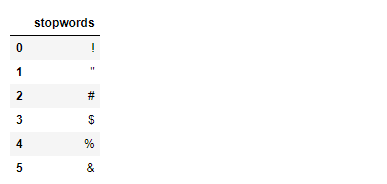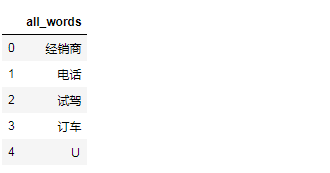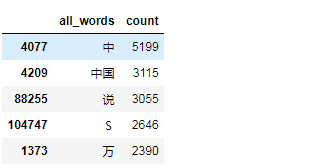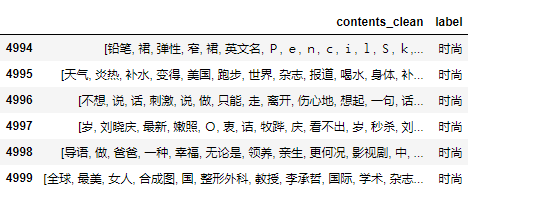以下内容笔记出自‘跟着迪哥学python数据分析与机器学习实战’,外加个人整理添加,仅供个人复习使用。
import pandas as pd
import jieba
import warnings
warnings.filterwarnings('ignore')
导入数据
df_news=pd.read_table(r'E:\R Python\Python 学习\@迪哥B站\迪哥-Python数据分析与机器学习实战\18:基于贝叶斯的新闻分类实战\data\val.txt',
names=['category','theme','URL','content'],
encoding='utf-8')
df_news=df_news.dropna()
print(df_news.shape)
df_news.head(1)

分词,使用jieba分词器

content_S=[]
for line in content:
current_segment=jieba.lcut(line)
if len(current_segment)>1 and current_segment !='\r\n':#换行符
content_S.append(current_segment)
content_S[12]

df_content=pd.DataFrame({
'content_S':content_S})
df_content.head(6)

导入停用词并删去文档中停用词
stopwords=pd.read_csv(r'stopwords.txt',
index_col=False,sep='\t',quoting=3,
names=['stopwords'],encoding='utf-8')
stopwords.head(6)

#定义删去停用词的函数
def drop_stopwords(contents,stopwords):
contents_clean=[]
all_words=[]
for line in contents:
line_clean=[]
for word in line:
if word in stopwords:
continue
#代码执行到continue时,本轮循环终止,进入下一轮循环
line_clean.append(word)
all_words.append(str(word))
contents_clean.append(line_clean)
return contents_clean,all_words
查看分词后结果:
contents=df_content.content_S.values.tolist()
stopwords=stopwords.stopwords.values.tolist()
contents_clean,all_words=drop_stopwords(contents,stopwords)
df_content=pd.DataFrame({
'content_clean':contents_clean})
df_content.head()

df_all=pd.DataFrame({
'all_words':all_words})
df_all.head()

计算词频
import numpy as np
#words_count=df_all.groupby(by=['all_words'])['all_words'].count()
words_count=df_all.groupby(by=['all_words'])['all_words'].agg({
'count':np.size})
words_count=words_count.reset_index().sort_values(by='count',ascending=False)
words_count.head(6)

词云展示
from wordcloud import WordCloud
import matplotlib.pyplot as plt
%matplotlib inline
import matplotlib
plt.rcParams['font.sans-serif']='SimHei'
plt.figure(figsize=(10,5))
wordcloud=WordCloud(font_path='C:\\Windows\\Fonts\\simhei.ttf',
background_color='white',
max_font_size=80)
wordfreq={
x[0]:x[1] for x in words_count.head(100).values} #将数据框模式转化为列表模式
wordcloud=wordcloud.fit_words(wordfreq)
plt.imshow(wordcloud)
plt.axis('off')

关键词提取:TF-IDF
import jieba.analyse
index=2400
print(df_news['content'][index])

content_S_str=''.join(content_S[index])
print(' '.join(jieba.analyse.extract_tags(content_S_str,topK=5,
withWeight=False)))
耐克 阿迪达斯 欧洲杯 球衣 西班牙
主题模型:LDA
格式要求:list of list 格式,分词后的整个语料
from gensim import corpora,models,similarities
import gensim
#http://radimrehurek.com/gensim/
#做映射,相当于词袋
dictionary=corpora.Dictionary(contents_clean)
corpus=[dictionary.doc2bow(sentence) for sentence in contents_clean]
lda=gensim.models.ldamodel.LdaModel(corpus=corpus,
id2word=dictionary,
num_topics=20)
#类似与Kmeans,自己指定k值
#一号分类结果
print(lda.print_topic(1,topn=5))
0.010*“男人” + 0.009*“说” + 0.009*“中” + 0.007*“女人” + 0.005*“节目”
for topic in lda.print_topics(num_topics=20,num_words=5):
print(topic[1])

分类
df_train=pd.DataFrame({
'contents_clean':contents_clean,
'label':df_news['category']})
df_train.tail(6)

标签处理
label_map={
'汽车':1, '财经':2, '科技':3, '健康':4,
'体育': 5,'教育':6, '文化':7, '军事':8, '娱乐':9, '时尚':10}
df_train['label']=df_train['label'].map(label_map)
df_train.head(6)

划分测试集与训练集
from sklearn.model_selection import train_test_split
X_train,X_test,y_train,y_test=train_test_split(df_train['contents_clean'].values,
df_train['label'].values,
test_size=0.2,
random_state=1234)
words=[]
for line_index in range(len(X_train)):
try:
words.append(' '.join(X_train[line_index]))
except:
print(line_index,word_index)
words[0]

词向量处理
#示例
from sklearn.feature_extraction.text import CountVectorizer
texts=["dog cat fish","dog cat cat","fish bird", 'bird']
cv=CountVectorizer()
cv_fit=cv.fit_transform(texts)
print(cv.get_feature_names())
print(cv_fit.toarray())
print(cv_fit.toarray().sum(axis=0))
[‘bird’, ‘cat’, ‘dog’, ‘fish’]
[[0 1 1 1]
[0 2 1 0]
[1 0 0 1]
[1 0 0 0]]
[2 3 2 2]
#也可几个词组合,可能型更多,精准度越高,但数据量较大时,矩阵可能会过于稀疏
from sklearn.feature_extraction.text import CountVectorizer
texts=["dog cat fish","dog cat cat","fish bird", 'bird']
cv=CountVectorizer(ngram_range=(1,4)) #一般到2即可
cv_fit=cv.fit_transform(texts)
print(cv.get_feature_names())
print(cv_fit.toarray())
print(cv_fit.toarray().sum(axis=0))
[‘bird’, ‘cat’, ‘cat cat’, ‘cat fish’, ‘dog’, ‘dog cat’, ‘dog cat cat’, ‘dog cat fish’, ‘fish’, ‘fish bird’]
[[0 1 0 1 1 1 0 1 1 0]
[0 2 1 0 1 1 1 0 0 0]
[1 0 0 0 0 0 0 0 1 1]
[1 0 0 0 0 0 0 0 0 0]]
[2 3 1 1 2 2 1 1 2 1]
对新闻语料进行词向量处理
from sklearn.feature_extraction.text import CountVectorizer
cv=CountVectorizer(analyzer='word',
max_features=4000,
l

vec=cv.fit_transform(words)
print(len(cv.get_feature_names()))
print(vec.toarray())
print(vec.toarray().shape)
4000
[[0 0 0 … 0 0 0]
[0 0 0 … 0 0 0]
[0 0 0 … 0 0 0]
…
[0 0 0 … 0 0 0]
[0 0 0 … 0 0 0]
[0 0 0 … 0 0 0]]
(4000, 4000)
建模
from sklearn.naive_bayes import MultinomialNB
classifier=MultinomialNB()
classifier.fit(vec,y_train)
test_words=[]
for line_index in range(len(X_test)):
try:
test_words.append(' '.join(X_test[line_index]))
except:
print(line_index,word_index)
test_words[0]

classifier.score(cv.fit_transform(test_words),y_test)
0.138
再利用TF-IDF进行词向量处理建模
from sklearn.feature_extraction.text import TfidfVectorizer
vectorizer=TfidfVectorizer(analyzer='word',
max_features=4000,
lowercase=False)
vectorizer.fit(words)
from sklearn.naive_bayes import MultinomialNB
classifier=MultinomialNB()
classifier.fit(vectorizer.fit_transform(words),y_train)
classifier.score(vectorizer.fit_transform(test_words),y_test)
0.17